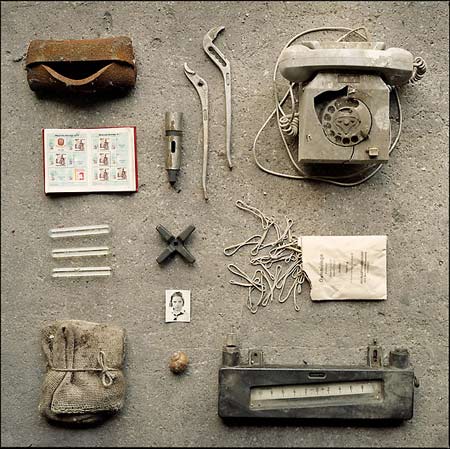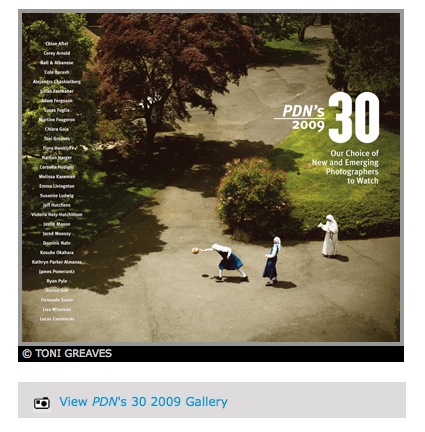
Classic photographs done as LEGOs !
Flickr "Classics in Lego"

Baseline Issues for the "How to Get a Gallery" Question
Each time I discuss how artists can best go about getting a gallery, this issue comes up. In response to yesterday's post, Zipthwung wrote:This whole discussion makes me want to vomit. Artists grovelling for shows? Where is their pride? Gallerists baiting artists into groveling for shows? The opportunity for abuse is obvious, and happens.There are two baseline points I'd like to make about this before I address the abuse issue.
1. Not every artist needs or should even be affiliated with a commercial art gallery. The system works really well for some and not at all for others. Because many commercial art galleries are good at generating press for their artists and exist to place work in prominent collections, though, I think there is a somewhat misguided view among younger artists in particular about how essential getting into a gallery is for their careers. It can be, but there are plenty of artists with galleries (even very high-profile galleries) whose careers are no better off (in fact sometimes worse) than many artists without galleries that I know. The key is to find a gallery that's a good match for your art and aspirations, NOT to find any gallery at any cost to your pride or goals. If no gallery is well suited for you to work with, then find other means of pursuing your dreams.
2. The notion that dealers (or anyone in the industry with power) expects or wants artists to grovel is a misinterpretation of the harsh realities that a) what they really want from artists is for them to make the most compelling, important artwork of their generation. They want artists to awe them, inspire them, teach them, and uplift them. Believe me. When it's well understood that an artist is doing that, the industry is all too happy to grovel at their feet. For the legions of artists not yet doing that, well, the other harsh reality is that b) you have a phenomenal amount of competition.
The advice I offer, which directs artists to consider what they can do on an interpersonal level to get a leg up on their competition for the limited slots in the gallery system, is not at all meant to recommend "groveling." It is meant to suggest, though, that artists approach this with the same formal courtesies they would a job application/interview. If you were applying for a position on the faculty at an art school, I don't think calling up the dean who has never heard of you and insisting that she call you back when she has an opening would endear you to her.
So to recap: Galleries are not the magic ticket to stardom and riches...they are but one option in the spectrum of venues by which artists can exhibit their work and hopefully advance their careers. If that venue seems a good match for your goals, though, the single easiest way to get a gallery is to make artwork so compelling that dealers beat a path to your door. Full stop. When that's not working out for you, though, don't take it personally that you're only one of dozens, if not hundreds, of artists approaching the dealer who said he wasn't looking at the moment. He's trying to make things happen for the artists he's already representing, trying to pay the bills, trying to get that review, trying to get that curator to stop by, and in this current climate just trying to survive himself....
About the potential for abuse. It's real of course. To help arm artists against it though, I'll refer back to baseline issue #1. A gallery is not Valhalla. It's not as if, to realize your dreams, you simply must do whatever it takes to get into one.
At the positively packed Town Meeting at the X-Initiative last night (hat tip to Elizabeth Dee and Lindsay Pollock for providing that opportunity for the art world to air some of its anxieties about the current state of things), Superdealer Jeffrey Deitch mentioned the legendary Times Square Show and pointed to all the empty store fronts in Soho and encouraged the artists in the audience to produce exhibitions in them. He garnered the most enthusiastic applause of the evening.
My point is there are other options out there, many of which are totally in the hands of artists themselves. No one needs to submit to abuse. When it's clearly uncomfortable to pursue the opportunity to work with a gallery, stop and look elsewhere.

COLAB
http://www.avocetportfolio.com/about.html
In the winter of 1976-77, I was drawn into a feverish sequence of gatherings in artists’ lofts in downtown New York City. The focus was the structure of an organization that would support the creation and sharing of art, defining purpose and forms for group activity. The group included a mix of about 26 artists; painters, writers, photographers, filmmakers and many who wanted to make everything.
It was a volatile and exciting mix. People had identified each other in schools, jobs, bars, the Whitney Program, Australia, and elsewhere. The earliest name of the group was the Green Corporation. The second name was Collaborative Projects, Inc. also known as COLAB, reflecting a shift in intention. Within two years, consensus replaced “executive decision.” COLAB was chaotic and fundamentally democratic. I found it highly compelling.
Projects included the “All Color News,” a cable TV show. There were exhibitions and stores in storefronts and lofts, international slow scan video, publications, and a pre-fax, pre-internet, communication transmission activity utilizing QWIP machines, procured from the Exxon Corporation by Liza Bear. Through a juicy and conflicted multi-year period of identity and structural definition, there was experimentation in and rich discussion of accessible content, political forces, technology, equity, corporate versus union models, and material resources.
During 1978-80, Coleen Fitzgibbons, Tom Otterness, Ulli Rimkus and I were the COLAB officers. We raised money for the group from the National Endowment for the Arts, the New York State Council on the Arts, and private sources. In June 1980, COLAB produced the wild and historic Times Square Show that included 250 artists. My archive of this period includes thorough and unique documentation including, photographs, Otterness’s hand drawn floor map, and meeting notes.
Making multiples was an important aspect of COLAB and they were sold in several versions of the A. More Store, named for Allan Moore. “Collaborative Projects” is now a generic term, midstream mainstream instead of the name of a provocative artists’ collective. Some of the artists have been famous and several have made valuable contributions as leaders and cultural activists.
The founding of Avocet with Jolie Stahl who had also been active in COLAB was my next foray into production and creative community building. We took great pleasure in group work, imagery linked to joy, the exploration of a new medium, and contributing to the development new non-toxic printmaking materials.

Books and more books.
The Blue Room
Eugene Richards
Phaidon Press
168 pages / 78 color photographs
Hardcover $100.00
This has got to be one of my favorite books (top 5) of last year and if it hadn't already been out for so long I would have given a thorough review on it.
"Eugene Richards was born in Dorchester, Massachusetts, a neighborhood of Boston. After graduating from Northeastern University with a degree in English and journalism, he studied photography with Minor White at MIT. In 1968 he became a health care advocate in eastern Arkansas. Two years later, he helped found a social service organization and a community newspaper, Many Voices, that reported on black political action and the Ku Klux Klan. After publication of his first two books, Few Comforts or Surprises: The Arkansas Delta (1973) and Dorchester Days (self-published in 1978), Richards was invited to become a nominee at Magnum. He was a member until he departed in 1995, returned to the cooperative in 2002, and departed for a second time in 2005.
Despite his success in other fields, Richards remains best known for his books and photo essays on cancer, drug addiction, poverty, emergency medicine, the mentally disabled, aging, and death in America. His intense vision and unswerving commitment have led him to become what many believe is America's greatest living social documentary photographer. This new body of work, entitled The Blue Room, is one of Richards' most personal works to date. It his is first-ever color project, and it brings together the overarching themes of all his work ''the transient nature of things'' in a beautiful and moving series of pictures of the landscape and abandoned houses of the American West, covering the states of Kansas, Colorado, Wyoming, Montana, Arkansas, Nebraska, New Mexico, and the Dakotas. This is the area where settlers came around the turn of the twentieth century, pursuing the promise of homesteads where they could build successful communities. However, in the wake of the Great Depression and the dust storms of the 1930s, the farms in this isolated, semi-arid region faltered and failed, leaving the land littered with forgotten homes.
Richards' photographs are a statement on the vulnerability of man in the face of the shifting economic opportunities and the climate; a commentary on the inevability of change. In these contemplative pictures we are inspired to imagine the lives of the homes' former occupants. Richards enigmatic pictures make The Blue Room a thought-provoking meditation on memory; a quiet yet incredibly powerful body of work."

Desire and Despair, with Marni Horwitz
I've had an Annie Lennox song in my head for two days.. the lyrics "desire, despair, desire, despair, so many monsters" are circling in my brain. And lest you think I'm about to throw myself off the Brooklyn Bridge, this is actually a good sign.
What, what, you ask? Yep, it's because I can't get Marni Horvitz's images off my mind, in particular her series Desire Despair: Pictures from the Czech Republic.
Horvitz isn't just good at naming her projects; the images fit the titles perfectly. These are washed-out, haunting, film-still worthy pictures. Take a look:
Showstudio and Weekend Video
Way back in 2000, SHOWstudio was a pioneering presence in the world of online 'zines. I remember Craig McDean's 2001 short film of supermodel Karen Elson (former bassist with The Smashin Pumpkins) and Hole, Melissa Auf der Maur, performing the song 'Devil's Plaything', shot at the Chelsea Hotel in New York, as an inspiration - showing what you could do with a hand-held camera, a good eye, cool friends, and access to some streaming video.
Ten years later, SHOWstudio are still at it. So just a simple appreciation.

American Youth
"American Youth" is a cross-section of today's 18-24 year olds done by Redux Pictures
They set up a "American Youth" website with a blog updated with out-takes and photographer's recollection. And they even twitter ! (Okay, I'm over twitter already)
Photographers with images in the book are: Marc Asnin, Ben Baker, Nina Berman, David Butow, Peter Frank Edwards, Danny Wilcox Frazier, Eros Hoagland, John Keatley, Andy Kropa, Erika Larsen, Gina LeVey, Joshua Lutz, Preston Mack, Kevin J. Miyazaki, Darcy Padilla, Mark Peterson, Michael Rubenstein, Greg Ruffing, Q. Sakamaki, Erin Siegal, Angie Smith, Ben Stechschulte, Brad Swonetz, Nathaniel Welch, and David Yellen.
photographers over a course of a year. This book's theme reminds me of Greenfield's "Fast Forward" (1997) and Nathaniel Welch's "Spring Broke" (2004) so I'm curious to take a look when it comes out in May 2009. (Interesting enough, Steve Appleford wrote the preface to "Spring Broke" and "American Youth")
The 240-page “American Youth” book examines the newest generation of 18-24 year olds in detail, observing young couples and Mormon missionaries, debutante balls and drunken tailgate stupors, war widows and B-boys, street kids and lobstermen. How are they different, and how are they exactly the same as the generations that came before? On these pages are Christian rock fans, lesbian gangstas and Obama volunteers. There are would-be pop stars waiting for a shot on American Idol, organic farmers living the hippie dream and tattooed Cobra gang members brooding in the Window Rock jail, Navajo Reservation. Another series of photographs asks young New Yorkers to think big: If you had the chance, what question would you ask God?



